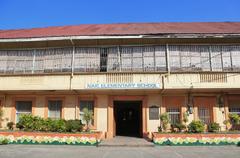
Comprehensive Guide to Visiting Casa Hacienda de Naic, Naic, Philippines
Publication Date: 01/08/2024
Introduction to Casa Hacienda de Naic
Casa Hacienda de Naic, located in the historic town of Naic in Cavite, Philippines, stands as a significant testament to the country’s rich colonial heritage and tumultuous struggle for independence. Originally constructed in the 19th century by Dominican priests, the structure served as a pivotal administrative and agricultural hub during the Spanish colonial era (Wikipedia). The hacienda’s robust architecture, characterized by stone walls and spacious courtyards, reflects a blend of Spanish and Filipino design elements, making it an architectural gem of its time.
The Hacienda played a crucial role during the Philippine Revolution, serving as a strategic base for revolutionary leaders, including Emilio Aguinaldo and Andres Bonifacio. The Naic Military Agreement, a key document in the revolution, was drafted within its walls, highlighting the site’s historical importance (Alchetron). Following the end of Spanish rule, the hacienda continued to serve significant roles during the American and Japanese occupations, further embedding its place in Philippine history.
Today, Casa Hacienda de Naic stands not only as a museum but also as a symbol of Filipino resilience and heritage. It attracts numerous visitors, including history enthusiasts, cultural scholars, and tourists seeking to delve into the Philippines’ colonial past. This comprehensive guide will provide you with detailed information on the hacienda’s history, visitor tips, and travel insights to make your visit enriching and memorable.
Table of Contents
- [Explore the Rich History and Visitor Information of Casa Hacienda de Naic in Naic, Cavite](#explore-the-rich-history-and-visitor-information-of-casa-hacienda-de-naic-in-naic-caviteexplore-the-rich-history-and-visitor-information-of-casa-hacienda-de-naic-in-naic-cavite)
- [Early Beginnings and Spanish Colonial Era](#early-beginnings-and-spanish-colonial-eraearly-beginnings-and-spanish-colonial-era)
- [Role in the Philippine Revolution](#role-in-the-philippine-revolutionrole-in-the-philippine-revolution)
- [American and Japanese Occupations](#american-and-japanese-occupationsamerican-and-japanese-occupations)
- [Post-War Period and Restoration Efforts](#post-war-period-and-restoration-effortspost-war-period-and-restoration-efforts)
- [Visitor Information for Casa Hacienda de Naic](#visitor-information-for-casa-hacienda-de-naicvisitor-information-for-casa-hacienda-de-naic)
- [Travel Tips for Visiting Casa Hacienda de Naic](#travel-tips-for-visiting-casa-hacienda-de-naictravel-tips-for-visiting-casa-hacienda-de-naic)
- [Special Events and Guided Tours](#special-events-and-guided-toursspecial-events-and-guided-tours)
- [Photographic Spots](#photographic-spotsphotographic-spots)
- [FAQ](#faqfaq)
- [Summary and Conclusion](#summary-and-conclusionsummary-and-conclusion)
- [References and Further Reading](#references-and-further-readingreferences-and-further-reading)
Explore the Rich History and Visitor Information of Casa Hacienda de Naic in Naic, Cavite
Early Beginnings and Spanish Colonial Era
Casa Hacienda de Naic, located in Naic, Cavite, Philippines, is a historical landmark that dates back to the Spanish colonial period. The hacienda system was introduced by the Spanish colonizers in the 16th century, and Casa Hacienda de Naic was one of the many haciendas established to manage agricultural lands. The hacienda served as the administrative center for the vast agricultural estates in the region, primarily focusing on the cultivation of rice, sugarcane, and other crops.
The structure of Casa Hacienda de Naic is a testament to Spanish colonial architecture, characterized by its robust stone walls, large wooden doors, and spacious courtyards. The building’s design reflects the Spanish influence on Filipino architecture, blending local materials and construction techniques with European styles.
Role in the Philippine Revolution
Casa Hacienda de Naic played a significant role during the Philippine Revolution against Spanish rule. In 1897, it became the site of the Naic Assembly, a crucial event in the history of the revolution. The assembly was convened by General Emilio Aguinaldo, the leader of the revolutionary forces, to discuss strategies and plans for the ongoing struggle for independence.
During the Naic Assembly, the revolutionary leaders drafted the Naic Military Agreement, which aimed to reorganize the revolutionary government and strengthen its military forces. This agreement was a pivotal moment in the revolution, as it marked a shift in the leadership and strategies of the revolutionary movement. The Casa Hacienda de Naic thus became a symbol of Filipino resistance and the quest for independence.
American and Japanese Occupations
Following the end of Spanish rule, the Philippines came under American control in 1898. Casa Hacienda de Naic continued to serve as an important administrative center during the American occupation. The building was used by American officials to oversee agricultural activities and implement new policies aimed at modernizing the agricultural sector.
During World War II, the Philippines was occupied by Japanese forces, and Casa Hacienda de Naic once again found itself at the center of significant historical events. The hacienda was used by the Japanese as a military headquarters and a detention center for Filipino guerrillas and suspected resistance fighters. The building’s strategic location and robust structure made it an ideal site for military operations.
Post-War Period and Restoration Efforts
After the end of World War II and the subsequent liberation of the Philippines, Casa Hacienda de Naic fell into a period of neglect and disrepair. The building’s historical significance, however, was not forgotten, and efforts to restore and preserve it began in the latter half of the 20th century.
In the 1970s, the Philippine government, recognizing the importance of Casa Hacienda de Naic as a cultural and historical landmark, initiated restoration projects to preserve the building’s architectural integrity and historical value. These efforts were supported by local historians, cultural organizations, and the community of Naic, who all contributed to the preservation of this important site.
Visitor Information for Casa Hacienda de Naic
Today, Casa Hacienda de Naic stands as a well-preserved historical site that attracts tourists, historians, and cultural enthusiasts from around the world. The building serves as a museum, showcasing artifacts, documents, and exhibits related to its rich history and the broader history of the Philippines.
Travel Tips for Visiting Casa Hacienda de Naic
For those planning to visit Casa Hacienda de Naic, here are some useful tips to ensure a memorable experience:
- Opening Hours: The museum is typically open from 9:00 AM to 5:00 PM, Tuesday to Sunday. It is advisable to check the official website or contact the museum for any changes in operating hours.
- Admission Fees: There may be a nominal entrance fee for visitors. Discounts are often available for students, senior citizens, and groups.
- Guided Tours: Taking a guided tour is highly recommended to fully appreciate the historical significance of the site. Knowledgeable guides provide in-depth information and answer any questions visitors may have.
- Photography: Photography is usually allowed, but it is best to confirm any restrictions with the museum staff. Flash photography may be prohibited to protect sensitive artifacts.
- Accessibility: The museum is generally accessible to visitors with mobility issues, but it is advisable to check in advance for any specific accessibility needs.
- Local Amenities: Naic offers various amenities, including restaurants, cafes, and souvenir shops, making it convenient for visitors to enjoy a full day of exploration.
Special Events and Guided Tours
Casa Hacienda de Naic hosts various special events throughout the year, including historical reenactments, cultural festivals, and educational workshops. Visitors are encouraged to check the museum’s official website or social media pages for updates on upcoming events.
Photographic Spots
The courtyard, with its lush gardens and historic architecture, offers excellent photographic spots for capturing the essence of Casa Hacienda de Naic. Visitors are encouraged to take photos and share their experiences with the broader community.
FAQ
-
What are the visiting hours for Casa Hacienda de Naic? The museum is typically open from 9:00 AM to 5:00 PM, Tuesday to Sunday. It is advisable to check the official website or contact the museum for any changes in operating hours.
-
How much are the tickets for Casa Hacienda de Naic? There may be a nominal entrance fee for visitors. Discounts are often available for students, senior citizens, and groups.
-
Is Casa Hacienda de Naic accessible to visitors with mobility issues? The museum is generally accessible to visitors with mobility issues, but it is advisable to check in advance for any specific accessibility needs.
Summary and Conclusion
Casa Hacienda de Naic encapsulates the rich tapestry of Philippine history, from its origins in the Spanish colonial era to its pivotal role in the revolution and beyond. Visiting this historical site offers a unique opportunity to step back in time and witness the architectural grandeur and historical significance that have shaped the region. The efforts to preserve and restore Casa Hacienda de Naic ensure that future generations can continue to learn from and appreciate this cultural landmark (MB).
The integration of the hacienda into the Naic Elementary School exemplifies a successful model of historical preservation combined with practical use, allowing students to engage directly with their heritage (Bluedreamer27). As you plan your visit, consider the tips and information provided to make the most of your experience. Whether you are a history buff, a cultural enthusiast, or a curious traveler, Casa Hacienda de Naic promises a journey through time that is both educational and inspiring. Stay updated with the latest events and information by following the official channels and immerse yourself in the rich history that this remarkable site has to offer.
References and Further Reading
- Wikipedia, Casa Hacienda de Naic, Wikipedia
- Alchetron, Casa Hacienda de Naic, Alchetron
- MB, The mosaics of Naic, MB
- Bluedreamer27, Casa Hacienda de Naic, Bluedreamer27
